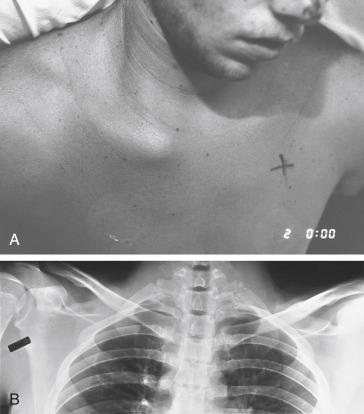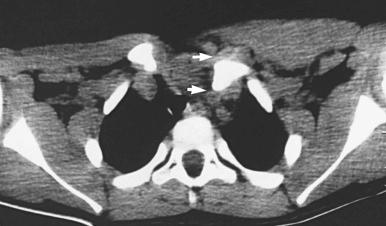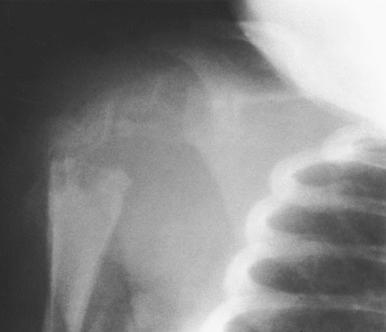Physical Address
304 North Cardinal St.
Dorchester Center, MA 02124
The clavicle, or collar bone, is an S-shaped bone anterior to the base of the neck. Through articulations with the sternum medially and with the scapula at the acromion process laterally, it serves as an osseous connection between the axial skeleton and the upper extremity. In cross section, the medial portion of the clavicle is rounded or prismatic, and the lateral third is flattened. The entire anterosuperior aspect of the clavicle is subcutaneous without significant muscular coverage.
The clavicle acts as an origin for the pectoralis major on the medial two-thirds of its anterior surface and for the deltoid on the lateral third. Inferiorly, through its middle third, it provides an attachment for the subclavius muscle and its enveloping clavipectoral fascia while acting as a point of attachment for both portions of the coracoclavicular and the acromioclavicular ligaments laterally and for the costoclavicular ligament medially. Posteriorly, the clavicle provides an attachment in its lateral third for the trapezius and for the clavicular head of the sternocleidomastoid muscle medially. The subclavian vessels and brachial plexus lie posterior to the junction of the medial two-thirds and the lateral one-third of the bone.
The clavicle is the first bone to begin ossification, which occurs from two primary centers that appear during the fifth or sixth week of fetal life. It is one of the last to completely ossify, as its medial physis does not close completely until 24 to 26 years of age in many males.
A fracture of the medial portion of the clavicle occurs infrequently in children and accounts for only about 5% of all pediatric clavicular fractures. Medial physeal fractures are more common than medial shaft fractures and may be mistaken for sternoclavicular joint dislocations.
The capsule of the sternoclavicular joint is more resistant to injury than is the physis of the medial portion of the clavicle. Because the physeal plate remains open until well into the young adult years, children and adolescents are more likely to sustain a physeal injury rather than an actual dislocation of the sternoclavicular joint. The most common mechanism of injury is axial compression of the shoulder toward the midline. Whether displacement of the lateral fragment occurs anterior or posterior to the sternum is determined by the secondary force vectors of this axial compression. A direct anterior-to-posterior force can generate a fracture or dislocation of the medial segment of the clavicle; in such a case, displacement is always posterior.
The patient usually is seen with a history of either a blow to the medial part of the clavicle or the sternal area or, more commonly, after a direct axial compression through the shoulder. Physical examination reveals local swelling and tenderness about the medial part of the clavicle ( Fig. 16.1 ). Anterior displacement presents with an obvious prominence in this area. When the displacement is posterior, symptoms of respiratory difficulty, dysphagia, dysphonia, or distended neck veins secondary to compression of adjacent structures may be present, although in some cases, no symptoms exist. Radiographs angled to minimize the effect of obscuring overlying tissues—for example, the “serendipity” view of Rockwood ( Fig. 16.2 ) or the Hobbs view, with the medial part of the clavicle and the sternoclavicular joints visualized bilaterally for comparison—usually confirm the diagnosis. However, computed tomography (CT) of the sternoclavicular joint is the preferred modality because it delineates the direction and extent of displacement most clearly. In addition, CT provides information regarding the relationship of the displaced clavicular fragment to neighboring structures, particularly the trachea, the esophagus, and great vessels ( Fig. 16.3 ).



Nondisplaced injuries of the medial portion of the clavicle or sternoclavicular joint can be managed symptomatically and have a good prognosis. A “bump” secondary to new callus should be expected and remodels to some extent with time, especially in a younger child. In many cases, anteriorly displaced fractures or dislocations require little treatment. Closed reduction can be attempted with longitudinal traction and direct pressure over the fracture. Usually, reduction is easily obtained but difficult to maintain, and redisplacement is a common result. If reduction fails or redisplacement occurs, further intervention is rarely indicated. Some remodeling may be expected, and little, if any, morbidity is noted beyond a minor cosmetic defect from the residual prominence. However, some patients will present with persistent pain and instability after an anteriorly displaced fracture/dislocation.
A posteriorly displaced medial clavicular fracture or posterior sternoclavicular dislocation may be life-threatening, and because of the risk of potential respiratory distress, determination of the presence of an adequate airway should be an essential part of the patient’s initial treatment. Closed reduction of these fractures can sometimes be attained by drawing the patient’s shoulder posteriorly and into abduction; this maneuver is facilitated by placing the patient supine with a folded towel or another type of bump placed between the scapulae to abduct the shoulder girdles. In addition, longitudinal traction on the involved upper extremity may assist in the reduction. Posteriorly displaced fractures that fail to reduce with closed techniques may be amenable to percutaneous reduction. After suitable anesthesia and skin preparation, a sterile towel clip is used to control the medial part of the clavicular shaft and manipulate it to its reduced position. It is generally advised that a thoracic or cardiac surgeon be available for potential assistance whenever reduction of a posteriorly displaced fracture is undertaken, particularly in those cases with evidence of premanipulation respiratory or vascular compromise, although well-documented cases of catastrophic bleeding are not reported.
Posterior fractures or dislocations tend to be more stable than anteriorly displaced fractures after reduction as a result of the geometry of the medial clavicle and physis, as well as the associated capsular structures. As such, maintenance of closed reduction is more common if the initial displacement is posterior. In most cases, reduction can be maintained successfully with a figure-of-8 strap and an arm sling for approximately 4 weeks. The medial clavicular physis has excellent remodeling capacity, and late pain and deformity are rare after stable reduction of displaced medial clavicular fractures.
Primary open reduction should be reserved for open injuries requiring débridement, for posteriorly displaced fractures that adversely affect neighboring vital structures and have failed reduction by percutaneous methods, and for significant anterior displacements that cannot be reduced (and maintained) by closed techniques. Internal fixation with Kirschner wires or smooth pins is inadvisable and has been associated with potentially serious complications. Alternatively, sutures placed strategically through drill holes in the outer portion of the adjacent sternum or sternoclavicular ligament and the medial section of the clavicle should suffice to stabilize the reduction. Waters and colleagues demonstrated good results with a suturing technique using nonabsorbable material, and Goldfarb and colleagues reported success with a figure-of-8 sternal wire after open reduction of posterior dislocations that had failed closed manipulation. Delayed operative reconstruction may be indicated in patients with pain and instability secondary to a prior anteriorly displaced injury. Fixation methods, including reduction and suture techniques, are similar to those used in primary operative procedures.
The clavicle is the most commonly fractured bone in the newborn. The incidence of birth fractures involving the clavicle ranges from 2.7 to 5.7 per 1000 term deliveries, and clavicular fractures account for 84% to 92% of all obstetric fractures. Choi et al reported an incidence of clavicle fractures complicating cesarean birth of 0.05% and felt that the primary risk factor in these patients was infant birthweight.
Clavicular injury at birth has been shown to correlate with increased birth weight of the infant, lower head-to-abdominal circumference ratio of the infant, inexperience of the delivering physician, and forceps delivery. In the vast majority of cases, the mechanism of fracture generation is secondary to axial compression of the shoulder girdle during passage through the birth canal. The most common fracture site is at the junction of the lateral and middle thirds of the bone. The fracture is usually minimally displaced; in many patients, it is unappreciated clinically and then discovered as a prominence over the shaft of the clavicle 7 to 10 days after birth as the fracture heals. Plain radiographs may be negative initially, but repeat images generally demonstrate periosteal reaction 7 to 14 days later. Kayser and associates described using ultrasound to image suspected neonatal clavicular fractures with excellent success. Occasionally, the fracture is manifested by pseudoparalysis of the arm secondary to discomfort with motion ( Fig. 16.4 ). In this instance, the differential diagnosis includes fracture of the proximal end of the humerus, brachial plexus palsy, and sepsis of the shoulder joint. It is important to remember that multiple diagnoses can coexist (e.g., fracture with brachial plexus palsy or fracture with infection). The presence of an asymmetric Moro reflex is useful for differentiating a true paralysis (brachial plexus injury) from other causes of diminished spontaneous shoulder motion secondary to pain (pseudoparalysis).

In a patient in whom upper extremity movements appear painful or in those with pseudoparalysis most likely secondary to a clavicular fracture, splinting or binding the upper extremity to the chest wall with a stockinette stretch bandage or a similar soft, expandable material for approximately 10 days is appropriate. Anecdotally, it may be easier and safer to clip the sleeve of the affected limb to the front of the infant’s shirt or gown to avoid the potential problems of loose and shifting bandages (so-called “onesie pinning”). Clavicular fractures in this age group heal extremely quickly without long-term sequelae. Congenital pseudarthrosis of the clavicle should not be confused with an acute fracture and usually can be differentiated easily by physical examination, lack of symptomatology, and radiographic appearance ( Fig. 16.5 ).

Fracture of the clavicle is one of the most frequent childhood fractures. The most common fracture is the diaphyseal shaft, and such fractures account for approximately 85% of all childhood clavicular fractures.
The most common mechanism of a clavicular shaft fracture is a fall onto the shoulder. This mechanism accounted for 87% of the 150 prospectively studied cases carefully documented in the report by Stanley and colleagues. Usually, the bone fractures where it changes shape (concave to convex and cross-sectionally from round to flat) within the middle third of the shaft. Less commonly, a direct blow may cause a clavicle fracture; this mechanism accounted for 7% of Stanley and colleagues’ cases. The remaining 6% of patients sustained fractures secondary to a fall on an outstretched hand. High-energy trauma is associated with fracture comminution and greater fragment displacement and with a consequently higher likelihood of injury to surrounding nonosseous structures such as the brachial plexus, neighboring vessels, or apex of the lung.
Characteristically, the child with an acute clavicular fracture holds the elbow of the affected limb with the opposite hand and tilts the head toward the affected side to minimize the pain associated with fracture displacement by the sternocleidomastoid and trapezius muscles. Radiographs at the time injury are often confirmatory, although for nondisplaced fractures, the results may initially be negative. The use of appropriate radiographic technique and careful attention to the periclavicular soft tissue shadow may detect subtle nondisplaced fractures. Overlying structures may obscure a medial physeal injury, and a Rockwood serendipity view (40-degree cephalad-directed tube angle) or Hobbs projection may be helpful. Children with appropriate histories and point tenderness over the clavicle but with negative primary radiographic results usually have callus at the site of injury on follow-up radiographs obtained 10 to 14 days after injury.
More than 200 methods of nonoperative management of a clavicular shaft fracture have been described. Most commonly, these fractures are managed with an apparatus that draws the shoulder backward (e.g., a figure-of-8 wrap or bandage) or a simple sling. Generally, total time of immobilization is about 3 to 4 weeks, and a gradual increase in activities is allowed as discomfort lessens. Contact sports are not recommended for approximately 6 to 8 weeks.
A common residuum of the injury is a prominence or bump at the site of the fracture caused by healing callus. The child and parents should be made aware of this possibility at the initial visit. Characteristically, the bump becomes less distinct as the bone remodels over the next 6 to 9 months. Long-term impairment as a consequence of a closed clavicular fracture managed by closed methods in childhood is rare.
Nonunion of a closed clavicle fracture in pediatric patients is extremely uncommon. Until recently, fewer than 15 cases had been described in the literature. In 2018, Pennock et al reported the data regarding clavicular nonunions from a nine-hospital multicenter study group. The authors identified 25 patients with nonunions. Twenty-two of the 25 patients were treated nonoperatively for the original injury, whereas three had undergone attempted surgical fixation as the index procedure. The primary risk factor associated with nonunion was a clavicular refracture. In addition, older patient age, male gender, and greater fracture displacement were felt to have a role in this very uncommon complication.
Débridement followed by open reduction is indicated for the rare open clavicular shaft fracture. Internal fixation may be necessary to prevent impingement of displaced sharp bone ends on neighboring vital structures or to prevent them from protruding through the wound. A 3.5-mm or 2.7-mm reconstruction plate is appropriate internal fixation; one should avoid using smooth pins because of concerns regarding migration. Appropriate wound closure, based on the severity of contamination and soft tissue injury, and external support in a figure-of-8 bandage and a sling are indicated.
Open reduction may also be indicated for significantly displaced, irreducible fractures (e.g., those that have buttonholed through the trapezius or the fascia, with tenting and potential compromise of the skin). Management of displaced clavicular fractures in adolescents without significant skin or soft tissue compromise has become more controversial, as surgeons have attempted to extend indications and results reported for adult patients to this younger population. Multiple authors have reported successful treatment of displaced fractures in adolescents. Kubiak and Slongo reported good success using intramedullary titanium elastic nails in pediatric and adolescent patients requiring internal fixation of clavicular shaft fractures. Vander Have and associates compared operative versus nonoperative treatment in adolescent patients and found a statistically significant lower time to radiographic union in those treated surgically. Five patients developed symptomatic malunions in the nonoperative group, but no nonunions or malunions occurred in the surgical cohort. Li et al found that the overall complication rate after operative plate fixation of pediatric clavicle fractures was 86%, with implant prominence or irritation being the most common single complication. Hagstrom et al reviewed outcomes of pediatric clavicle fractures managed with either surgical or nonoperative methods. The authors reported no difference in outcome scores, return to activity, or mean time to achieve full range of motion between the two groups. Overall, current opinion continues to favor nonoperative treatment of closed pediatric clavicular fractures. A survey of the Pediatric Orthopaedic Society of North America membership was undertaken, which presented four different case scenarios involving pediatric clavicle fractures to its members. In all situations, the majority of respondents preferred nonoperative treatment for closed fractures. Despite these apparent opinions, as well as the high rate of reported complications in the literature, a review of medical records from a large, urban US pediatric medical center demonstrated a statistically significant increase in the percentage of midshaft clavicle fractures in patients aged 10 to 18 treated operatively with plate fixation from 1999 to 2011.
Become a Clinical Tree membership for Full access and enjoy Unlimited articles
If you are a member. Log in here